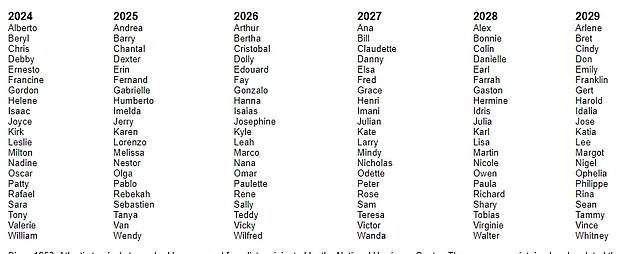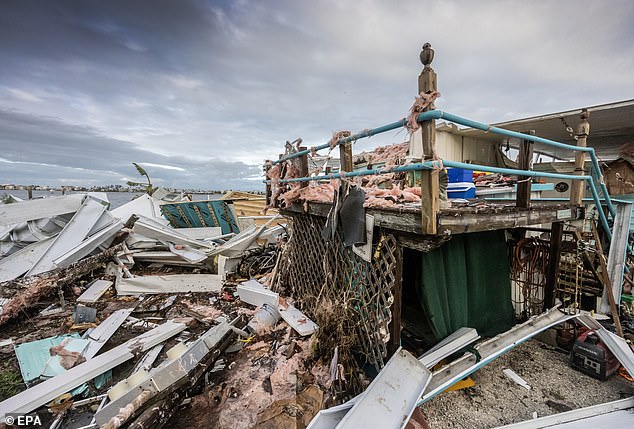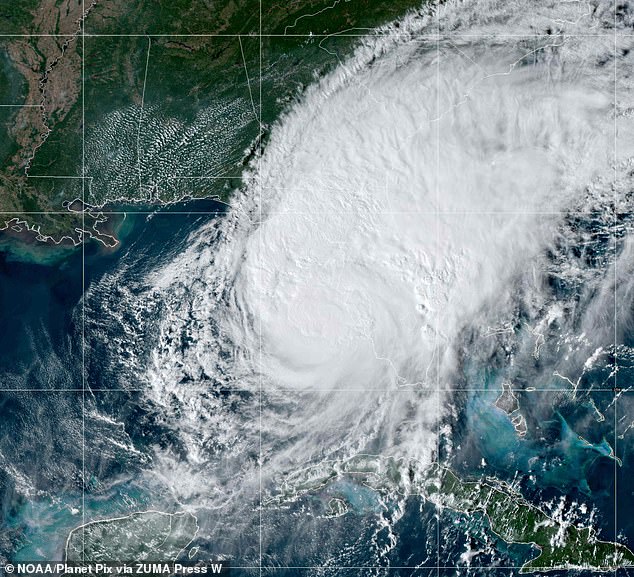As Floridians deal with the devastation of Hurricane Milton this morning, one thing is clear: the name Milton will long evoke painful memories for Floridians, along with Helene, Debby and Ian.
All of these names, and many others, have been associated with deaths and billions of dollars in property damage.
But how do hurricanes get their names?
They are predetermined years in advance by the World Meteorological Organization (WMO).
The WMO maintains six lists of 21 names in alphabetical order that rotate every six years.
Hurricane Milton slammed into Florida yesterday, bringing up to 20 inches of rain, 100 mph wind gusts and a deadly series of tornadoes to the Sunshine State.
The letters Q, U,
In the event that the number of named storms exceeds 21, the WMO uses its supplementary list of names.
This is a new change in the system. Until 2021, the agency used Greek letters to refer to tropical storms when its list of names was exhausted.
But the committee eliminated this practice for fear of confusion, since the letters Zeta, Eta and Theta sounded too similar.
There is a chance that the number of named storms could surpass the WMO list this year, as the National Oceanic and Atmospheric Administration (NOAA) has forecast up to 25 named storms for the 2024 Atlantic hurricane season.
Milton is the 13th named storm of the 2024 season, which has so far seen four tropical storms and nine hurricanes.
The storm made landfall as a Category 3 hurricane near Sarasota, Florida, around 8:30 p.m. ET on Wednesday.
Milton now returns to the sea, leaving more than three million people without power and four confirmed deaths in its wake.

Hurricane names are predetermined years in advance by the World Meteorological Organization (WMO). The WMO maintains six lists of 21 names in alphabetical order that rotate every six years.

Milton is the 13th named storm of the 2024 season, which has so far seen four tropical storms and nine hurricanes.
Milton’s name will likely be retired at the end of the season.
According to the National Hurricane Center, a hurricane’s name is retired when “a storm is so deadly or costly that future use of its name on a different storm would be inappropriate for obvious sensitivity reasons.”
Some notable retired names include Harvey, Maria and Irma in 2017, Sandy in 2012, Katrina in 2005, Frances in 2004, Andrew in 1992 and Hugo in 1989.
These storms are remembered not only for the immediate destruction and loss of life they caused, but also for the lasting impact they had on communities and infrastructure.
For example, nearly two decades later, many New Orleans residents are still suffering from the effects of Hurricane Katrina, especially those from marginalized communities.
The list of names for the 2024 hurricane season includes Alberto, Beryl, Chris, Debby, Ernesto, Francine, Gordon, Helene, Isaac, Joyce, Kirk, Leslie, Milton, Nadine, Oscar, Patty, Rafael, Sara, Tony , Valerie and Guillermo.
The earliest evidence of named tropical storms comes from Puerto Rico during the 16th century.
The people of the island named the hurricanes after the Roman Catholic saint they represented on the day the hurricane hit.
The first record of a named tropical storm hitting Puerto Rico is Hurricane San Roque, which hit the southwestern part of the island in August 1508.
Puerto Ricans continued this tradition for centuries, until the 1960s.
The first storm not named after a saint was Tropical Storm Frances, which made landfall on the island on October 2, 1961.
But in the United States, scientists tracked tropical storms and hurricanes by year and the order in which they occurred during that season until the 1950s, according to the National Ocean Service.
However, this system proved to be confusing, disorganized, and difficult to convey to the general public.
In 1950, the United Nations created the WMO and three years later, the agency decided to use everyday names to make tracking hurricanes and transmitting information about them to the public easier and more efficient.
Storms are typically named when they reach tropical storm status, meaning they reach wind speeds of 39 to 73 mph.
When wind speeds reach 74 mph or more, the storm is classified as a hurricane.
At first, only female names were given to tropical storms and hurricanes.
This practice was taken from the military phonetic alphabet, according to convoy of hopea non-profit humanitarian organization.
But feminists in the 1960s opposed the use of female names for destructive natural disasters.
In 1978, male and female names were used to identify North Pacific storms, and this was later adopted in 1979 for Atlantic and Gulf of Mexico storms.


